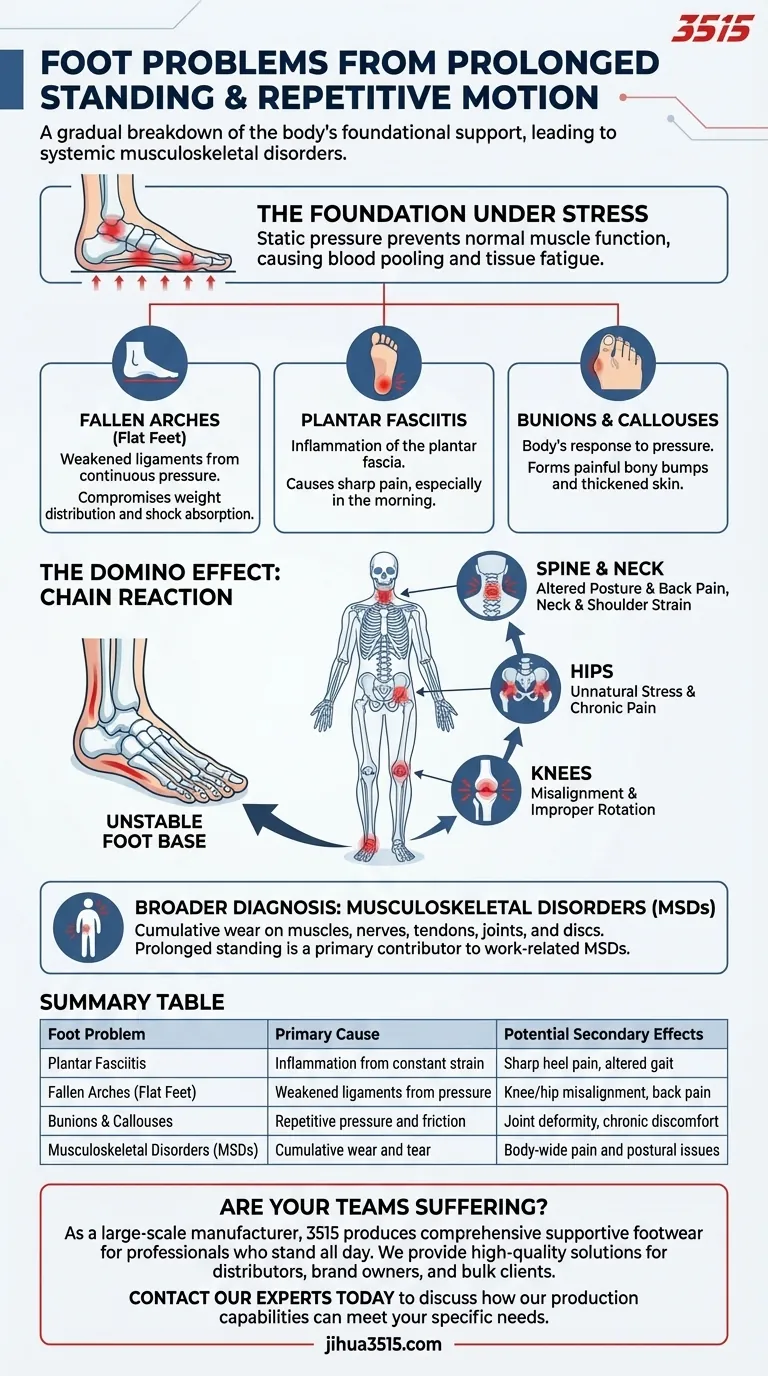In short, repetitive motion and prolonged standing can cause a range of significant foot problems, including plantar fasciitis, fallen arches (flat feet), bunions, and callouses. These issues often extend beyond the feet, leading to secondary injuries in the knees, hips, spine, and even the neck due to the body's interconnected structure.
The central issue isn't just foot fatigue; it's a gradual breakdown of your body's foundational support system. What begins as a foot problem can trigger a cascade of musculoskeletal issues, affecting your posture and overall health.

The Foundation Under Stress: How Standing Affects Your Feet
Prolonged standing places your feet under constant, unyielding pressure. This static load prevents the muscles from contracting and relaxing normally, which is essential for pumping blood back to the heart. This leads to blood pooling and tissue fatigue, creating an environment ripe for injury.
The Collapse of the Arch
The arches of your feet are your natural shock absorbers. Over time, continuous pressure from standing can weaken the ligaments and tendons that support them. This can lead to fallen arches, also known as flat feet, a condition that compromises your body's ability to distribute weight and absorb impact effectively.
Inflammation of Key Tissues
One of the most common complaints is plantar fasciitis. This is the inflammation of the plantar fascia, a thick band of tissue that runs across the bottom of your foot. Constant strain causes micro-tears and inflammation, resulting in sharp, stabbing pain, especially in the morning.
Surface-Level Skin and Bone Issues
The body responds to constant pressure by trying to protect itself. This can lead to the formation of painful bunions (a bony bump at the base of the big toe) and callouses (thickened patches of skin). The references also note that prolonged pressure can contribute to issues like plantar warts.
The Domino Effect: When Foot Problems Affect the Entire Body
Your feet are the foundation of your entire skeletal structure. When this foundation becomes unstable, it sets off a chain reaction that travels up the body. This is why foot problems are rarely just about the feet.
A Disrupted Kinetic Chain
Changes in your foot structure, like fallen arches, alter your gait and posture. Your body must compensate for this instability, forcing other joints and muscles to work in ways they weren't designed to.
Impact on Knees and Hips
With an unstable foot base, your knees and hips may rotate improperly to compensate. This misalignment places unnatural stress on the joints, leading to chronic pain and increasing the risk of secondary injuries.
Reaching the Spine and Neck
This chain of compensation continues upward. An altered posture from foot issues can lead to chronic back pain as the spine struggles to remain balanced. Eventually, this can even manifest as strain and pain in the neck and shoulders.
Understanding the Broader Diagnosis: Musculoskeletal Disorders
Many of these individual conditions fall under the umbrella of musculoskeletal disorders (MSDs). This is a critical concept to understand because it frames the issue not as a minor annoyance, but as a serious occupational health risk.
What is an MSD?
An MSD is an injury or disorder of the muscles, nerves, tendons, joints, cartilage, and spinal discs. It is not the result of a single acute event but of cumulative wear and tear on the body.
Why Standing is a Major Contributor
Prolonged standing is a primary cause of work-related MSDs. The constant strain, lack of movement, and tissue fatigue directly contribute to the conditions discussed, from plantar fasciitis to chronic back pain. It is a systemic issue, not just a collection of unrelated symptoms.
Making the Right Choice for Your Goal
Understanding these risks allows you to take proactive steps to protect your health. Your approach should be dictated by your current situation.
- If your primary focus is preventing future pain: Invest in proper, supportive footwear and consider using anti-fatigue mats to mitigate the constant pressure on your feet.
- If your primary focus is addressing existing pain: Recognize that foot, knee, and back pain are likely interconnected and that stabilizing your foundational foot support is a critical first step.
Ultimately, treating your feet as the crucial foundation of your entire body is the key to long-term musculoskeletal health.
Summary Table:
| Foot Problem | Primary Cause | Potential Secondary Effects |
|---|---|---|
| Plantar Fasciitis | Inflammation from constant strain | Sharp heel pain, altered gait |
| Fallen Arches (Flat Feet) | Weakened ligaments from pressure | Knee/hip misalignment, back pain |
| Bunions & Callouses | Repetitive pressure and friction | Joint deformity, chronic discomfort |
| Musculoskeletal Disorders (MSDs) | Cumulative wear and tear | Body-wide pain and postural issues |
Are your teams suffering from work-related foot and body pain? As a large-scale manufacturer, 3515 produces a comprehensive range of supportive and durable footwear designed specifically for professionals who stand all day. We provide high-quality solutions for distributors, brand owners, and bulk clients to protect your workforce's health and productivity. Contact our experts today to discuss how our production capabilities can meet your specific needs.
Visual Guide

Related Products
- Wholesale Safety Footwear Manufacturer for Bulk & Custom OEM Orders
- Custom Wholesale Leather Safety Boots Direct Factory Manufacturing
- Customizable Anti-Smash Safety Boots for Wholesale & Private Label Manufacturing
- Premium KPU Injection Athletic Style Safety Shoes
- Factory-Direct Wholesale Canvas Boots with High-Traction Rubber Soles
People Also Ask
- Why is manufacturer diversity and inclusion important in work boot design? For Superior Fit, Safety & Comfort
- Do moc toe boots have steel toe? Get Durable, Safety-Compliant Footwear
- Is safety toe better than steel toe? A Guide to Choosing the Right Protection
- What is a safety-toe in a boot? Your Guide to Choosing the Right Protection
- Is there a downside to steel toe boots? Weighing Protection Against Daily Comfort



















